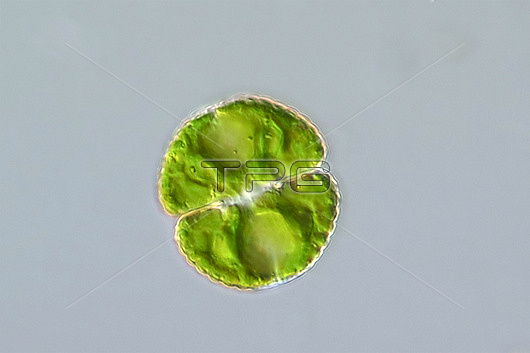
Unicellular alga (Cosmarium botrytis), light micrograph. Cosmarium botrytis is a variety of microscopic green algae belonging to the Desmidiaceae family. This highly cosmopolitan freshwater species has a worldwide distribution, being found on every continent. This microalgae is one of many Chlorophyceae species found in continental waters, where it figures at the very beginning of aquatic food chains, as phytoplankton. The cytoplasm features two large chloroplasts, each containing two pyrenoids. Algae are chlorophyllous plants with no stems, roots or leaves. Their vegetative apparatus is called a thallus in the case of macroscopic species (in this particular case, theyre called thallophytes). They are capable of photosynthesis, and generally live in aquatic environments, in fresh, brackish or marine water, although there are a few rare cases of terrestrial algae. They can be grouped into two main categories: macroscopic algae, large in size, which colonise coastlines to within a few dozen meters of the surface, where they live a fixed life. They are no longer found below a depth of 50-60 metres, as light is almost totally absorbed beyond this depth, making photosynthesis impossible, microscopic algae (and a few large algae that live freely in the water), which populate the first few meters below the surface, just about everywhere in the oceans, and make up phytoplankton, the initial and primordial link in all aquatic food chains. Many microscopic algae have a filamentous appearance, their thallus consisting of an alignment, branched or unbranched, of numerous identical cells. Magnification: x450 when printed at 10 centimetres wide.
| px | px | dpi | = | cm | x | cm | = | MB |
Details
Creative#:
TOP30268442
Source:
達志影像
Authorization Type:
RM
Release Information:
須由TPG 完整授權
Model Release:
N/A
Property Release:
N/A
Right to Privacy:
No
Same folder images:

 Loading
Loading